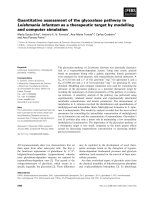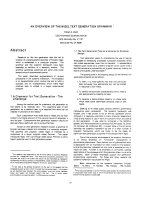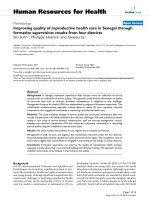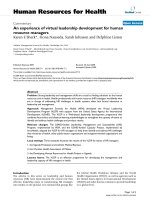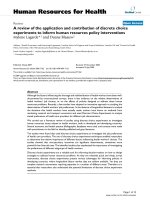báo cáo sinh học:" An assessment of the eye care workforce in Enugu State, south-eastern Nigeria" doc
Bạn đang xem bản rút gọn của tài liệu. Xem và tải ngay bản đầy đủ của tài liệu tại đây (352.37 KB, 6 trang )
BioMed Central
Page 1 of 6
(page number not for citation purposes)
Human Resources for Health
Open Access
Research
An assessment of the eye care workforce in Enugu State,
south-eastern Nigeria
Boniface Ikenna Eze* and Ferdinand Chinedu Maduka-Okafor
Address: Department of Ophthalmology, University of Nigeria Teaching Hospital, Ituku-Ozalla, Enugu, Nigeria
Email: Boniface Ikenna Eze* - ; Ferdinand Chinedu Maduka-Okafor -
* Corresponding author
Abstract
Background: The availability and distribution of an appropriate eye care workforce are fundamental to
reaching the goals of "VISION 2020: The right to sight", the global initiative for the elimination of avoidable
blindness launched jointly by the World Health Organization and the International Agency for the
Prevention of Blindness with an international membership of nongovernmental organizations, professional
associations, eye care institutions and corporations. Periodic evaluation of these parameters is important
in the journey towards achieving these goals. The objectives of the study were to determine the availability
and distribution of human resources for eye care delivery in Enugu Urban, south-eastern Nigeria.
Methods: The study was designed as a cross-sectional descriptive survey, the setting for which was all
public and privately owned eye care facilities in Enugu Urban, Enugu State, south-eastern Nigeria, in
October 2006. The health map of Enugu Urban and the hospital register of the Public Health Department
of the Enugu State Ministry of Health were used to identify the eye health care facilities in Enugu Urban.
A structured, pretested, researcher-administered questionnaire was used to capture data on cadre and
distribution of the eye care personnel in these facilities.
Relevant population data were obtained from the Enugu Regional Office of the National Population
Commission. Descriptive statistical analysis was used to generate percentages and proportions. Eye care
personnel-to-population ratios were calculated and compared to World Health Organization
recommendations.
Results: Out of Enugu State's population of three million, Enugu Urban accounts for 22%. The population
of Enugu Urban is distributed between the three-component Local Government Areas comprising Enugu
North (31%), Enugu South (30%) and Enugu East (39%). There are 45 eye care facilities (public: 31 (69%);
private: 14 (31%)) employing 252 eye care workers (public: 226 (90%); private: 26 (10%)) aged 18 to 63
(mean = 36.1 years, SD = 2 years) comprising males (36: 14%) and females (216: 86%), giving a male-to-
female sex ratio of 1:6. The available eye care workforce is unevenly distributed between Enugu North
(128: 51%), Enugu South (65: 26%) and Enugu East (59: 23%) Local Government Areas.
Conclusion: Using broad and crude World Health Organization standards for minimum provider-to-
population ratios, there is a sufficient eye care workforce in Enugu Urban. However, the maldistribution
of the workforce creates a major barrier to uptake of eye care services. Policy modifications could reverse
this maldistribution.
Published: 12 May 2009
Human Resources for Health 2009, 7:38 doi:10.1186/1478-4491-7-38
Received: 1 December 2008
Accepted: 12 May 2009
This article is available from: />© 2009 Eze and Maduka-Okafor; licensee BioMed Central Ltd.
This is an Open Access article distributed under the terms of the Creative Commons Attribution License ( />),
which permits unrestricted use, distribution, and reproduction in any medium, provided the original work is properly cited.
Human Resources for Health 2009, 7:38 />Page 2 of 6
(page number not for citation purposes)
Background
Primary Eye Care (PEC) is the provision of essential,
affordable, accessible, practical and sustainable eye health
care to the general population. PEC delivery uses the hor-
izontal integration matrix model proposed by the World
Health Organization (WHO) to incorporate PEC pro-
grammes into the existing Primary Health Care (PHC)
structure [1,2]. Our definition of the eye care workforce
includes all individuals who directly or indirectly provide
care related to promotion, protection, and improvement
of population eye health [3].
The eye care workforce has been identified as the bedrock
of "VISION 2020: The right to sight", the global initiative
for the elimination of avoidable blindness launched
jointly by the World Health Organization and the Interna-
tional Agency for the Prevention of Blindness with an
international membership of nongovernmental organiza-
tions, professional associations, eye care institutions and
corporations. Vision 2020 offers the framework to define
the appropriate, adequate, evenly distributed and satisfac-
torily motivated/remunerated eye care workforce to actu-
alize the objectives of the programme [4]. In addition to
the workforce, money, mobility, facilities (fixed and
mobile) and management are the other complementary
requirements for effective delivery of comprehensive eye
care in the spirit of VISION 2020 [5].
Eye care includes promotive, preventive, curative or reha-
bilitative services; delivery locations include institution-
based, community-based or both. There are three catego-
ries of eye care personnel: full-time eye care workers, inte-
grated eye care workers and community-based eye care
workers (medical and non-medical) [5,6]. The route of
delivery and the type of eye care delivered are determined
by public health needs, desired health impact, available
resources and the prevailing socioeconomic environment
[6].
In 1997, WHO established VISION 2020 recommenda-
tions for improvements in the eye care workforce in sub-
Saharan Africa. By the year 2000, the region was expected
to have the following eye care personnel-to-population
ratios: one ophthalmologist per 500 000 people; one dis-
pensing optician or optometrist per 500 000 people; one
cataract surgeon/diplomate ophthalmologist per 250 000
people; one ophthalmic medical assistant or ophthalmic
nurse per 500 000 people; one primary eye care trainer per
one million people [7].
Unfortunately, however, economic reforms imposed by
international monetary institutions on Nigeria, a debtor
nation, resulted in budget restrictions that led to staff
recruitment and development restrictions in all public
sectors, including the health sector [8]. These measures
negatively affected the health sector and its ability to offer
eye care of quality. Eye care delivery, along with other
ancillary services such as dental care, is subject to even
tighter restrictions than more basic "life and death" serv-
ices during periods of economic distress [3,5]. Restrictions
in the public sector's ability to provide eye care have
prompted some growth in private eye care services [9-11].
This study was conducted to measure the availability and
distribution of human resources for eye care delivery in
Enugu Urban, south-eastern Nigeria, especially in com-
parison to the VISION 2020 goals of WHO. Findings are
intended to inform health policy formulators in monitor-
ing and planning for further interventions in their existing
programmes for prevention of blindness [9,12].
Settings, data sources and methods
Enugu State is one of the 36 states of the Federal Republic
of Nigeria; Enugu Urban is its administrative capital terri-
tory. Enugu State is divided into 17 Local Government
Areas (LGAs); of these, three LGAs, comprising Enugu
North, Enugu South and Enugu East, make up Enugu
Urban. Enugu East has a comparatively significant rural
component, as it was only recently carved out from the
periphery of Enugu North LGA.
Geographically, Enugu State lies in the south-east of
Nigeria, with a population of three million. The Enugu
Urban population is about 707 000, distributed among
Enugu North (31%), Enugu South (30%) and Enugu East
(39%) [13].
Enugu State is located in the tropical rainforest climatic
region, with patches of derived savannah. There are two
seasons (rainy and dry) and the urban population is pre-
dominantly ethnic Ibos, although immigrants from other
parts of the country also reside in the state [14]. The urban
population is made up of mainly civil servants, traders,
artisans and students/pupils of the various educational
institutions in the state.
This is a descriptive cross-sectional survey of public and
private eye health care facilities in Enugu Urban con-
ducted between January and June 2006.
The health map of the three urban LGAs of Enugu North,
Enugu South and Enugu East was obtained from their
respective health departments, which provided informa-
tion on the location of available eye health care facilities.
Private facility data were obtained from the registry of pri-
vate hospitals of the Public Health Department of Enugu
State Ministry of Health. The State's Public Health Depart-
ment also provided further information on cadre disposi-
tion of eye care personnel working in public or private eye
care centres in Enugu State outside Enugu Urban.
Human Resources for Health 2009, 7:38 />Page 3 of 6
(page number not for citation purposes)
Information on the types of in-service training pro-
grammes available for full-time eye care workers in public
service was obtained from the Human Resources Depart-
ment of Enugu State Ministry of Health. Relevant popula-
tion figures based on projections from the 1991 census
were obtained from the Enugu Zonal Office of the
National Population Commission.
We visited each eye care facility to collect data on age, sex
and cadre of eye care personnel in each facility by means
of a structured, pretested, researcher-administered ques-
tionnaire.
Ancillary staff, such as drivers, laboratory workers and
security men, and non-permanent staff – including
interns and those doing their mandatory post-graduation,
one-year National Youth Service – were excluded from the
study.
Data management
Data were analysed by means of the Statistical Package for
Social Sciences (SPSS) software to generate percentage
and proportions. Eye care personnel-to-population ratios
were calculated and compared with WHO recommenda-
tions for VISION 2020.
Ethics
Prior to commencement of this study, ethical clearance
was sought and obtained from the Public Health Depart-
ment of Enugu State Ministry of Health and the Enugu
Zonal Office of the National Population Commission.
Informed consent for participation was obtained from the
research subjects by the researchers.
Results
The population of Enugu State is three million. Of this,
Enugu Urban has a population of 707, 000 (22%). The
urban population is distributed among the LGAs as fol-
lows: Enugu North (218 000: 31%), Enugu South (210
000: 30%) and Enugu East (278 000: 39%).
There are 45 eye health care facilities in Enugu Urban,
consisting of 31 (69%) public and 14 (31%) private facil-
ities. Of the 31 public centres, two (6%) are tertiary, four
(13%) are secondary and 25 (81%) are primary-level eye
care centres.
Facility distribution by LGAs showed 20 (44%) in Enugu
South: one cottage hospital, five health centres, two
health clinics, eight private optometrist clinics, four pri-
vate ophthalmologist clinics; in Enugu North 17 (38%):
two university teaching hospital eye clinics, one cottage
hospital, five health centres, three health clinics, five
health posts, one private optometry clinic; in Enugu East,
eight (18%): two cottage hospitals, five health centres,
one private optometry clinic.
There were 252 eye care workers: 26 (10%) privately
employed and 226 (90%) public employees. Of these, 36
(14%) were males and 216 (86%) were females, giving a
male-to-female ratio of 1:6. The age range was 18 to 63
(mean = 36.1 years, SD = 2 years). The age and sex distri-
bution of workers are shown in Table 1.
The distribution of staff by cadre and LGA is shown in
Table 2. The comparison of eye care personnel-to-popula-
tion ratios with WHO recommendations is shown in
Table 3.
There is not a single ophthalmologist (fellow or certified
specialist – diplomate), cataract surgeon or ophthalmic
nurse working in either the public or private sector in
Enugu State outside Enugu Urban, although there are four
optometrists (all in private practice) outside Enugu
Urban.
The available in-service training programmes for public
eye care workers include workshops, update courses,
refresher courses and bonded scholarship for employees
seeking full-time, long term, in-service training usually
lasting for one year or longer.
The bonded scholarship programme is usually chosen by
staff nurses/midwives for their one-year ophthalmic nurs-
ing training and by medical officers going for residency
training in ophthalmology.
There is no available training programme for cataract sur-
geons and diplomate ophthalmologists.
Table 1: Age and sex distribution of eye care workers
Age (years) Sex Total
MF
10–20 1 15 16
21–30 1 55 56
31–40 11 74 85
41–50 10 34 44
51–60 11 34 45
61–70 2 4 6
Total 36 216 252
Source: Eye care workforce survey in Enugu State, 2006
Human Resources for Health 2009, 7:38 />Page 4 of 6
(page number not for citation purposes)
In Enugu State there are eight health training institutions
open to qualified applicants from the public: two univer-
sity teaching hospitals, one national orthopaedic hospital,
one federal neuropsychiatric hospital, two schools of
health technology and two schools of nursing/midwifery.
Referrals, usually through written referral letters, originate
from lower to higher-level eye care centres.
Discussion
Taken as a whole, the eye care workforce in Enugu Urban
and Enugu State would appear to be adequate by WHO
standards [7]. However, the gross maldistribution of the
available eye care personnel among the three component
LGAs in Enugu Urban and between Enugu Urban and its
rural population is a cause for serious public eye health
concern. This maldistribution also affects the private
health sector. This runs contrary to the fundamental prin-
ciple of fair and even distribution of available human
resources for eye care delivery as established by VISION
2020 [3].
Similar maldistribution patterns of the available eye care
workforce have been reported elsewhere from other devel-
oping countries similar to Nigeria [3,8,15-19]. Nwosu
[20], Quarcopoome [21], Katung [22], Abiose [23] and
Table 2: Cadre and distribution of eye care workers by LGA
Cadre of personnel Enugu North
n (%)
Enugu South
n (%)
Enugu East
n (%)
Total (Enugu Urban)
n (%)
Ophthalmologist
• Fellow 13 (77) 4 (24) 0 (0.0) 17 (100)
• Diplomate 0 (0.0) 0 (0.0) 0 (0.0) 0 (100)
Optometrist 9 (50) 8 (44.4) 0 (0.0) 17 (100)
Ophthalmic nurse 23 (100) 0 (0.0) 0 (0.0) 23 (100)
Medical officer 6 (50) 4 (33.3) 2(16.7) 12 (100)
Staff nurse/midwife 26 (50) 13 (25) 13 (25) 52 (100)
Community health officer 7 (37) 6 (32) 6 (32) 19 (100)
Community health extension worker 36 (34) 30 (28) 40 (38) 106 (100)
Primary eye care trainer 5 (100) 0 (0.0) 0 (0.0) 5 (100)
Total (%) 125 (51) 65 (26) 61 (25) 251 (100)
Source: Eye care workforce survey in Enugu State, 2006
Table 3: Eye care personnel-to-population ratios by LGA compared with WHO recommended ratios
Enugu North Enugu South Enugu East Total (Enugu Urban) WHO recommended ratio
Population 218 000 210 000 278 000 707 000
Ophthalmologist 1:17 000 1:53 000 0:278 000 1:42 000 1:500 000
Optometrist 1:24 000 1:26 000 1:278 000 1:39 000 1:500 000
Ophthalmic nurse 1:9 000 0.210 000 0.278 000 1:28 000 1:400 000
Primary eye care trainer 1:36 000 0:210 000 0.278 000 1:118 000 1: 1 000 000
Community health extension worker 1:6 000 1:7 000 1:8 000 1:7 000 1:1 000 000
Source: Eye care workforce survey in Enugu State, 2006
Human Resources for Health 2009, 7:38 />Page 5 of 6
(page number not for citation purposes)
Eze et al. [24] have also reported similar trends in the dis-
tribution of the available eye care workforce and high-
lighted the resultant problems of economic and
geographical barriers to uptake of eye care if not urgently
addressed. It has been established that opportunities for
professional development/advancement and living con-
ditions/availability of social amenities are more impor-
tant determinants of health worker mobility than
remuneration [3,25]. In the present report, enhanced
career progression opportunities, availability of social
amenities and higher prospects for lucrative part-time pri-
vate practice in Enugu Urban are implicated in fuelling
this maldistribution.
In Enugu, we observed WHO's recommended pyramid-
style distribution of eye care cadres, in which lower-cadre
workers are more numerous at the base, while higher-
cadre workers are fewer and located at the apex [1,7]. This
observation agrees with various ophthalmic workforce
survey results previously reported [13,19,23]. However, in
Enugu, we noted an absolute dearth of middle-level oph-
thalmic workforce (cataract surgeons and diplomates),
likely due to the local lack of training programmes for
these cadres of eye care workers.
Consistent with the trend worldwide, the sex distribution
of the available eye care workforce shows a preponder-
ance of females over males (85.7% versus 14.3%), with a
male-to-female ratio of 1:6. This is in keeping with WHO
report that the majority (70% to 80%) of the world's
health care workers are females [18]. This has negative
implications for workforce mobility, since married
females in Africa are less mobile than their male counter-
parts, secondary to their gender-related domestic func-
tions.
The age distribution shows that a majority (62%) of the
eye care health workers in our study are 40 years of age or
younger. This implies a long-term temporal stability of
the available eye care workforce, since a large proportion
of eye care personnel still have many productive working
years before the mandatory retirement age of 60 years in
Nigeria.
Conclusion
In the aggregate, Enugu Urban seems to have an adequate
eye care workforce to deliver essential eye care. Unfortu-
nately, there exists a worrisome maldistribution of the
available eye care workforce in Enugu Urban and the rural
population of Enugu State. This is a fundamental depar-
ture from the principle of equal/universal access to eye
care as enshrined in the VISION charter.
The apparent sufficiency of eye care workforce in Enugu
Urban suggested by the findings of this survey under-
scores a major shortcoming of using VISION 2020/WHO
recommendations for eye care personnel-to-population
ratios in assessing eye care workforce availability. The
authors suggest a review of the VISION 2020/WHO rec-
ommendations to give appropriate weighting to such var-
iables as population size/density and spatial distribution
of available eye care personnel. The results of our study
suggest that health policy-makers should schedule peri-
odic staff audits of eye care workers in Nigeria's districts to
create the data set that would allow redistribution of the
available human resources for eye care delivery.
In the absence of any cataract surgeon or diplomate oph-
thalmologist in the region, policy-makers may want to
consider training the middle-level ophthalmic workforce
to provide those services. Specifically, interested potential
trainees should be sponsored for training while arrange-
ments for local establishment of the training programme
are made. Additionally, to retain the current crop of rural
eye care workers and possibly attract more, policy formu-
lators should address the rural eye care workers' limited
access to professional development and career progres-
sion by creating scholarship programmes and giving pref-
erential sponsorship to workshops/refresher courses
specifically for rural eye care workers.
Furthermore, the authors advocate intersectoral coopera-
tion between health and other relevant sectors to provide
basic social amenities where health facilities are located.
Clearly, in the limited-resource setting of Enugu State,
encouraging private eye care providers to fill the vacuum
created by this maldistribution is not a viable public
health option; private eye care services are exorbitant and
often inaccessible to the poor. Finally, fair and even distri-
bution of the available eye care workforce should have an
overriding influence over other factors when making job
postings in the public health sector.
Competing interests
The authors declare that they have no competing interests.
Authors' contributions
BIE conceptualized the research, designed the study pro-
tocol, participated in data collection, analysis and inter-
pretation and wrote the initial draft of the manuscript.
FCMO participated in data collection, analysis and inter-
pretation; made substantial intellectual input into the
manuscript; and approved the final version.
Acknowledgements
The authors gratefully acknowledge the assistance of the staffs of all the eye
care centres in Enugu Urban, National Population Commission Enugu,
Enugu State Ministry of Health and the Health Departments of Enugu
North, Enugu South and Enugu East Local Government Areas during the
course of this study.
Publish with Bio Med Central and every
scientist can read your work free of charge
"BioMed Central will be the most significant development for
disseminating the results of biomedical research in our lifetime."
Sir Paul Nurse, Cancer Research UK
Your research papers will be:
available free of charge to the entire biomedical community
peer reviewed and published immediately upon acceptance
cited in PubMed and archived on PubMed Central
yours — you keep the copyright
Submit your manuscript here:
/>BioMedcentral
Human Resources for Health 2009, 7:38 />Page 6 of 6
(page number not for citation purposes)
References
1. World Health Organization: Primary Health Care: Report of the Interna-
tional Conference on Primary Health Care: Alma-Ata, USSR, 6–12 Septem-
ber 1978. Geneva 1978.
2. Konyama K: Essential components of primary eye care. J Com
Eye Health 1998, 11(26):17-19.
3. Odusote K: People deliver eye care: managing human
resources. J Com Eye Health 2006, 18(56):117-119.
4. World Health Organization: National VISION 2020 implemen-
tation data. [ />regional-data/en/].
5. Ozemela CP: Qualitative eye care delivery in a depressed
economy. Nigerian Journal of Ophthalmology 1996, 4(1):33-37.
6. Boateng W: Who can carry out primary eye care? J Com Eye
Health 1998, 11(26):22-24.
7. World Health Organization: Global Initiatives for the Prevention of Avoid-
able Blindness Volume 61. Geneva; WHO/PBL/97; 1996:22-30.
8. Ummuro A: The health worker recruitment and deployment
in Kenya: an emergency hiring programme. Human Resources
for Health 2008, 6:19.
9. Lee PP, Jackson CA, Kelles AD: Estimating eye care workforce
supply and requirements. Ophthalmology 1995,
102(112):1965-1971.
10. Samandari R, Kleefield S, Hammel J, Mehta M, Crone R: Privately
funded quality health care in India: a sustainable and equita-
ble model. Int J Qual Health Care 2001, 13(4):283-288.
11. Purohit BC: Inter-state disparities in health care and financial
burden on the poor in India. J Health Soc Policy 2004, 18(3):37-60.
12. Eze BI, Chuka-Okosa CM, Ezepue UF: Material resources for eye
care delivery in urban southeastern Nigeria. Orient Journal of
Medicine 2004, 16(2):13-21.
13. National Population Commission: Final Results of 1991 Population Cen-
sus of Nigeria, Enugu State. Abuja 1991:2.
14. Abegunde MA, Adegoke KA, Onwumere GA, Dahiru A: Senior Sec-
ondary Geography 3 Ikeja, Longman, Nigeria; 1991:94-96.
15. Dussault G, Franceschini MC: Not enough there, too many here:
understanding geographical imbalances in the distribution of
the health workforce. Hum Resources for Health 2006, 4(1):12.
16. Murthy GV, Gupta SK, Bachani D, Tewari HK, John N: Human
resources and infrastructure for eye care in India: current
status. Natl Med J India 2004, 17(3):128-34.
17. Nguyen L, Ropers S, Nderitu E, Zuyderduin A, Lubago S, Hagopian A:
Intent to migrate among nursing students in Uganda: Meas-
ures of brain drain in the next generation of health profes-
sionals.
Human Resources for Health 2008, 6:5.
18. Geiser SC, Vassileva P, West SK: Ophthalmology in Bulgaria.
Arch Ophthalmol 1994, 112(5):687-690.
19. World Health Organization: The World Health Report 2000. Health Sys-
tems: Improving Performance. Geneva 2000.
20. Nwosu SNN: Resources for eye health services in Anambra
State I: Ophthalmic manpower. Nigerian Medical Journal 1994,
27(2&3):50-54.
21. Quarcoopome CO: Impact of national economy on eye care
standards: Random observations. Nigerian Journal of Ophthalmol-
ogy 1997, 4(1):13-20.
22. Katung PY: Availability of primary health care services in Bar-
kin Ladi Local Government Area of Plateau State, Nigeria.
Nig J Med 1998, 7(4):161-164.
23. Abiose A: VISION 2020: The challenge for Nigeria Ophthal-
mology in the next millennium. Congress Lecture of the Ophthal-
mological Society of Nigeria Annual Congress/Scientific Conference, Abuja,
24th September, 1999 .
24. Eze BI: Primary eye care in Enugu North Local Government
Area of Enugu State: an evaluation of resource availability
and utilization. Dissertation presented to National Postgraduate Med-
ical College of Nigeria for award of final fellowship (FMCOphth) in Ophthal-
mology 2000.
25. Meng Q, Yuan J, Jing L, Zhang J: Mobility of primary health work-
ers in China. Human Resources for Health 2009, 7:24.

